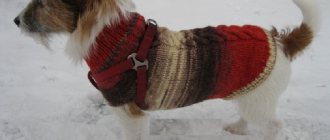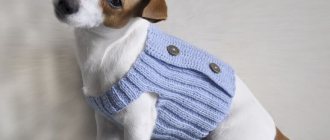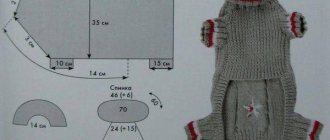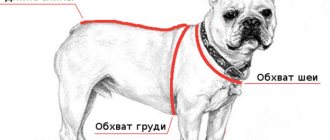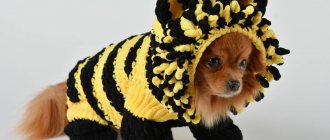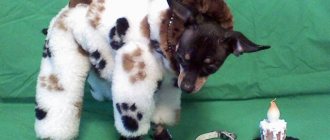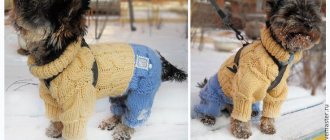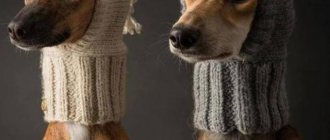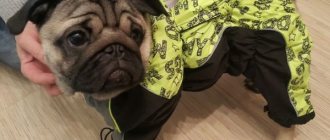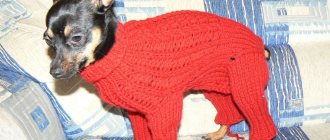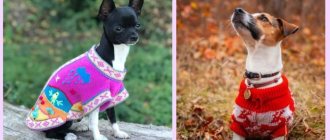The Yorkshire Terrier is a small domestic dog with fluffy and very beautiful fur. But despite the fact that these dogs have such beautiful hair, this does not save them from the cold in our harsh winter. This is the main and main reason that happy owners of dogs of this breed think about clothes for their pet. Clothes for your pet can be bought in pet stores, which our world is teeming with today. However, more and more people are inclined to sew it themselves. Everyone has their own reasons for this: some save a lot of money, some express love and care in this way, and some simply enjoy this activity. But clothes for your four-legged friend can not only be sewn, but also knitted. Do-it-yourself knitted clothes for a Yorkie with patterns is not the easiest task, but it is quite possible if desired.
So, before you start knitting clothes for your dog, it would be advisable to familiarize yourself with how this can be done. Firstly, any product can be knitted or crocheted. What's the difference?
We knit with our own hands
Before starting work, you need to knit a sample of the selected knitting, casting on 10 loops.
Having knitted 3 cm, measure the length of the resulting sample and calculate how many loops you need to cast on the finished product. Each model has its own instructions that belong only to it. We will indicate points that will be required for some models:
- each part of a sweater or vest can be knitted separately, followed by stitching, or it can be knitted in the round, without seams;
- can be knitted with sleeves (jackets, sweaters) and sleeveless (vests);
- experienced knitters can use different patterns for knitting (braids, tracks, colored patterns);
- use different colors of thread when working, the product will only benefit from this;
- the finished product can be decorated with beads, ribbons, embroidery, lace, and fur trim.
Sweater knitted
To pattern a sweater for a dog, you will need to calculate the required number of loops (see above). In our case, we got 64 loops.
To knit a sweater you will need 5 knitting needles (circular knitting):
- We start knitting from the neck, cast on 64 loops (16 for each). We knit a 1x1 elastic band of the required length. Please note that the neck can be bent in half, like in golf. After the elastic we move on to stocking stitch (with knit stitches).
- Next, the calculation of loops for knitting raglan begins. Mark the first stitch of the row with a pin marker or thread of a different color. Having counted 25 loops, mark the 25th. Next we knit 10 loops, 19 loops, 10 loops. We knit the marked 4 loops with facial loops, and before and after them we make yarn overs. In the next row we knit yarn overs with facial loops, etc. Thus, in every second row the number of loops increases and the product begins to expand.
- Next we continue knitting according to the pattern. This is how you need to tie it to the beginning of the sleeves.
- Having reached the beginning of the sleeve, you need to re-pin 10 loops on one sleeve, and similarly on the other sleeve, and continue knitting in the round. We leave the loops for the sleeves alone for now.
- When there are 2–3 cm left until the end of the work, we again move on to knitting an elastic band. It will help you narrow the sweater for a tighter fit.
- Let's return to the sleeves. We cast on 10 loops and knit in the round with a 1x1 elastic band to the desired length. The second sleeve is knitted in the same way.
The sweater is ready. All that remains is to decorate it as your imagination dictates. It can be complemented by a hat with holes for the ears or a hood.
A knitted sweater for a dog is knitted in the same way, only this model will not be knitted in the round, but according to the front-to-back principle on two knitting needles. The measurements and pattern will be the same. At the waist, you can change the style a little and switch to elastic. This model will look especially good on miniature lady dogs with a thin waistline.
Crochet jacket
We suggest crocheting a blouse for your beloved pet. We will knit it in the round, using a simple double crochet stitch made from mohair yarn. The convenience of crocheting lies in the fact that you can work without a pattern, but simply by trying on the product, from time to time checking the correctness of the execution by fitting. In case of an error, it is easy to rip it apart and continue working after checking.
Let's write down the instructions step by step:
- We start working from the neckline, knitting a chain of air loops along a length equal to the girth of the dog’s neck. We connect the chain and continue to knit in the round with stitches.
- Increases will be needed for expansion. Also, in a circle, after 10–15 columns we make an increase. To do this, we make two double crochets in one column of the product. We knit several rows without changes, measure and, as necessary, add the number of loops. Having reached the beginning of the sleeves, cut off the thread and put the top part of the sweater aside.
- Using the same pattern, we knit two sleeves, separately casting on the required number of loops in the chain for each.
- Let's return to the first detail. Now you need to separately knit the back according to the front-to-back principle and the chest, decreasing the loops at the armholes.
- So, the holes for the sleeves are marked, we connect together the front (part of the sweater on the chest) and the back (the back of the blouse), and continue to knit the sweater in the round to the desired length.
- Please note that the jacket should be shorter on the stomach. Therefore, we tie the back of the product to the very tail. The back is elongated for greater heating.
- All that remains is to sew on the finished sleeves and decorate the resulting clothes (see the section “Knitting with your own hands”).
sleeveless shirt
The sleeveless vest can be knitted or crocheted. When knitting, use the same pattern that we used to knit the sweater and jacket. The only difference is that you don’t have to knit the sleeves. But the armhole will have to be finished with a hook, knitting several rows with regular stitches.
Knitting a sweater for a dog
( 3 ratings, average: 5.00 out of 5)
I’ll tell you step by step how to knit a sweater for a dog. This is my dog Zosya in a sweater that I knitted for her myself. Crochet. It’s already cold, one might say, winter is outside, the dog is freezing and shaking so much, even its paws are jumping. So I had to knit a sweater for her. She wears it with pleasure, even gets angry when I take it off. And he’s very happy when we get dressed. He also snatches the sweater from my hands and runs merrily around the apartment. With a sweater in his mouth. That's a lot of positive emotions for both the dog and me!
Do you want to create for your dog the same “work of art” of knitted art, as they say, “haute couture”? In this case, you yourself will act as a couturier. So, let's get started, crocheting a sweater for the dog.
Decor and decoration of the product
More experienced craftswomen can experiment with different patterns and ornaments during the knitting process. You can also show your imagination and use several types of threads, creating interesting color combinations. For example, you can make a contrasting edging on the neck, sleeves and bottom of the product.
You can use a variety of elements to decorate a sweater. The decor of clothing for an animal may be practically no different from the decoration of a human sweater. You can use a variety of brooches, buttons, clasps, rhinestones, pockets, etc. A fur trim on the product will help give it a winter look. Clothes will be even warmer if fur skins are sewn onto them. In this way you can create an imitation of a spectacular vest on a sweater.
Embroidery and lace will add sophistication and sophistication to the finished product. Thus, beautiful beaded collars are often made along the edge of the collar. Flowers and leaves made from satin ribbons look good.
One of the simplest ways to decorate a product is applique. It is necessary to cut pieces of fabric or leather. Both ready-made elements for decorations and from parts are cut out. For example, these could be circles, flowers, dog bones and others. The design is attached to the blouse using threads. At the same time, it is better to sew it by hand using a beautiful finishing seam. In the future, you can knit a hat, scarf, skirt or other accessories to this sweater, as well as pick up a handbag and boots. Stores sell ready-made stripes and stickers.
A beautiful and warm sweater, knitted by yourself, will protect your beloved pets from rain, snow or wind. You can crochet a product quite quickly and even a beginner can do it, because... no special patterns or drawings are needed. We hope that this article was useful and will help you create a spectacular outfit for your beloved dog.
Let's start with the hook
There are many techniques for crocheting. Let's look at two of them:
- Moroccan technology;
The use of this technique provides such advantages as the tightness of the knitted clothing and retention of shape for a long time. Typically, sleeveless vests, blankets and capes are knitted using this technique, which turn out very beautiful.
- Freeform knitting technique.
In this technique, first, a full-size pattern is drawn up and only then the elements of the future clothing are knitted. As a result, all elements are connected to each other using a thread or hook. The freeform knitting technique will take a little more time, but it will be worth it. Clothes made using this technique are absolutely original and unique.
Related article: Do-it-yourself finger theater made from paper in kindergarten
But what to do with the fact that crocheted dog clothes are not warm? This problem can also be solved, and there are several options for getting out of this situation:
- You can use a lining that is sewn from the inside out. It is important to note that this option will significantly complicate the washing process. However, if your pet also has other clothes, this will not be a problem;
- The second option is to decorate products with ornaments that can be embroidered on the finished item or knitted - this will help retain heat.
Sweater with Norwegian pattern
Sizes: XS; S; M; L.
Chest circumference: 28-32; 40-44; 50-54; 60-66cm
Back length: 24-26; 32-34; 40-42; 48-52cm.
We will need:
- h/w yarn (50g per 100m), coffee color – 50; 100; 150; 200g; *same, white – 50; 50; 100; 100g; *same, chocolate color – 50; 50; 50; 100g; *set of toe knitting needles No. 3.5 – for size XS; *set of toe knitting needles No.3;
- circular knitting needles No. 3.
Patterns:
- persons Ch.: when knitting in the round, all sts in all rows are knitted, when knitting forward/reverse, we alternate r. persons p. with a row of purl;
- elastic band: 2l.x2i.
Patterns of the Norwegian pattern for knitting a sweater for a dog - see below.
Density: facial. Ch. 22p. for 30r. equal to 10 cm by 10 cm.
Description
Let's start knitting a sweater for a dog using sock knitting needles. We dial on sp. No3 coffee yarn 52; 76; 100; 124p. and knit in a round cut for 6; 8; 10; 12cm. Let's go to sp. No3.5 and knitting faces. Ch. In the first row of this pattern we add 8 stitches. at regular intervals. We get 60 in work; 84; 108; 132p. Next, for knitting, we use the Norwegian pattern patterns in the specified sequence:
- for solution XS: A-1; A-2; A-4;
- for solution S: A-1; A-2; A-3; A-4;
- for solution M: A-1; A-2; A-3; A-2; A-4;
- for solution L: A-1; A-2; A-3; A-2; A-3; A-4.
Instructions for making increases/decrements:
- when performing the last row of pattern A-1, add 5 at equal intervals; 7; 9; 11p. Total 65; 91; 117; 143p.;
- when performing the last r. scheme A-2 for dits XS and M we subtract 1 p., and for dits S and L we add 1 p. Total 64; 92; 116; 144p.
At height 4; 6; 9; 12 cm from the collar we divide the knitting: closed. 1p., transplant 11; 17; 23; 23p. on aux. sp. (we will knit the belly on these stitches), close. 1 stitch, on the remaining stitches we continue knitting the back according to the patterns. On 10; 14; 18; 22 cm we transfer these points to the auxiliary. knitting needle and return to working on the tummy. We knit it to a height equal to the back. Next, we connect both parts for general circular knitting, while in place of the previously decreased 2 stitches. we dial new 2p.
After completing the patterns, we continue working with coffee thread. At 15; 20; 25; 30cm closed for the tummy average 10; 14; 18; 22p. We continue to knit the back, closing on both sides in each 2 p.: 1; 3; 4; 6 times in 2 p., 9; 8; 9; 8 times 1 p., 1; 3; 4; 6 times in 2 p., 1 time in 3 p. Total 22; 32; 42; 52p. C 29; 38; 47; 52cm from the collar for knitting a sweater for a dog we use sp. No3.
We replant the p. on them and pick up the edges. row of loops. We get 84; 112; 144; 188p. We switch to circular knitting and perform 3; 6; 9; 12 rub. cutting with coffee yarn, 2p. with the same rice and chocolate yarn. Next R. closed P.
For the sleeves, we raise them along the edge of the armholes with knitting needles No. 3 36; 44; 52; 60p. coffee yarn and make 5; 8; 12; 17r. cutting Then we switch to the chocolate thread and knit another 2p. cutting Next R. closed P.
How to take measurements and make calculations
How successful the product will be and how it will fit on the dog largely depends on the correct measurements taken. But small Yorkies and Toys can be very nimble and difficult to hold when trying to measure them. You will have to resort to outside help.
Basic measurements that need to be taken to create dog clothes:
- Chest circumference. Measured behind the front legs at the widest part.
- Neck circumference. Measure under the chin, at the area of greatest narrowing;
- Back length. Stretch a measuring tape from the collar to the base of the tail;
- Armhole depth. For a pullover with one pair of leg sleeves, measure the circumference of the widest part of the front paw. When creating a jumpsuit that covers all 4 limbs, this measurement must also be taken from the hind limbs.
- Leg length. This is the distance from the armpit to where the cuff should end. For the front and hind legs this segment will be of different lengths.
Also, when making overalls, you will need to measure the walking distance between the paws on the side. This will help you understand when to move from knitting the back to the panties.
Important! Once the dog has been measured, a full-size pattern drawing should be made. Having a ready-made sample of knitted fabric, it will not be difficult to calculate the size of the set row and other parameters
Correctly taken measurements will help you knit a comfortable item.
Features of knitting sweaters for dogs
Remember , dogs have a fundamentally different body configuration from humans. Therefore, no patterns based on the “human” logic of constructing clothes are suitable for dogs at all. I tried - nothing works!
Moreover, all dogs are different - height, paw length, volume, back length, neck length, neck girth, etc. Often you can’t find the right clothes for your dog in a pet store. Zoska, for example, has long legs. All the store-bought clothes for Zoska are somehow scanty, the paws stick out “naked”. Moreover, if the clothes are suitable for my dog in terms of width, chest and tummy volume, then the length must be short. And vice versa - the overalls, no matter how many times we tried them on - if the length of the back is just right, then the width - they hang.
Therefore, I am forced to create all the clothes for Zosechka myself.
When creating clothes for your dog, you need to adhere to the basic principle:
- Remember that the distance between the paws on the chest and stomach of a dog is always much less than the distance between the paws measured across the back. This means that the back is always much wider than the front.
Jacket for dogs as a necessity
Sweatshirts not only keep dogs warm, but also protect them from dirt, rain and snow. They allow you to keep the animal clean and dry, without unnecessary bathing.
Knitted sweaters are suitable as home wear, or outdoor wear when there is no frost. To secure the jacket to the animal's body, you can use zippers, buttons, Velcro, hooks or buttons, and they can be placed on the back or stomach.
In order to knit an excellent sweater for your pet, you need to make a pattern for the future product.
Required measurements
- neck circumference;
- chest circumference;
- waist circumference;
- back length.
Fashionable purple jacket for a dog
It is better to choose warm and soft yarn so that it does not irritate the delicate skin of a small dog. You can limit yourself to threads of the same color, but if your imagination allows, you can create interesting things using jacquard motifs or openwork knitting. Using melange thread makes it possible to knit a sweater quickly and easily, while at the same time moving away from boring monochromatic colors.
What you need for a sweater and how to choose yarn
To crochet a sweater, you don't have to buy new, expensive yarn. You can take the remnants of threads from already finished previous items or unravel an unnecessary item. Stores offer a huge assortment of threads, and their choice is determined primarily by the owner’s personal tastes and financial capabilities.
You will also need a hook and sewing supplies such as scissors, needle and thread. The required accessories depend on the style of the product. You may need buttons, snaps, zippers and other elements.
Important! An interesting combination would be, for example, a dog’s blouse and the owner’s scarf, knitted from the same threads. Therefore, if you decide to buy yarn, then it is better to take it with a reserve, just in case.
Step-by-step description of knitting a sweater for a pet
It's easier to make a sweater for your pet with detailed and clear descriptions. We offer you 4 interesting models of sweaters for dogs, made on knitting needles. The dogs in these things are simply adorable, and the handsome dogs themselves will not want to take them off after a walk.
Model 1
A sweater with a Norwegian pattern in gray will look chic on a small dog (for a miniature poodle or Yorkie).
To work you need:
- yarn of matching colors;
- knitting needles No. 3.
Description:
We cast on the required number of loops with stocking needles and perform a 2*2 rib stitch with a height of 6-7 cm. Then we move on to a simple stockinette stitch and at the same time 8 increase loops. You can move on to diagrams of Norwegian patterns. At a height of 4-12 cm, the knitting will need to be distributed over additional knitting needles.
Knit the back and front separately. Next, sew the side seams.
Knit the sleeves separately from the rest of the work.
Model 2
A delicate sweater made from melange yarn will fit well on short and stocky dogs, such as a pug or others.
To work you need:
- knitting needles No. 5 and 6;
- melange yarn - 150 g.
Description:
This pattern is knitted like a regular sweater (not raglan). We start from the back, making it wider. The product begins with an elastic band and continues with stockinette stitch. A small deviation for the armholes.
The front shelf is somewhat narrower than the back.
The sleeves are two small parts.
The low collar is made of 1*1 elastic.
Model 3
A blouse with arans looks very good. But for a dog sweater, you shouldn’t make aranas on the sleeves and the front front. All this will only disturb the pet. It is enough to decorate only the back with arans.
To work you need:
- yarn Alize Cashmere 100% wool;
- stocking needles.
Diagram for model 3
Description:
You need to knit with raglan and start from the collar.
Gate. Cast on 32 stitches on the needles. Knit 4 rows with an elastic band 1*1, then with an elastic band 2*1, for it you need to add one loop above each knit stitch. After 4 rows of this elastic band, switch to a 2*2 elastic band and make inconspicuous additions for it.
Raglan. Knit according to the patterns, at the same time make additions at 4 points for a neat raglan. The front and sleeves are stockinette stitch. The back is immediately made according to the pattern from the Arana pattern.
Front/back. The back and front are knitted in the round, but the front is finished a little earlier, for this you need to leave the loops on an additional needle. Knit the back, then pick up loops along the edge to knit the elastic around the entire fabric (front and back). The bottom elastic is knitted similarly to the collar elastic, but in the reverse order.
Sleeves. Knit each sleeve in a circle and finish the front stitch of the fabric with an elastic band. This is the same elastic band as on the collar of the product, but in reverse order.
Here is the finished product.
Model 4
Raglan for dogs from below. A very beautiful model with a small braid tied at the bottom. This is an ideal sweater for a small dog (Chihuahua, etc.).
To work you need:
- 2 skeins of baby pekhorka yarn, 50 g each;
- knitting needles No. 3.
Diagram for model 4
Description:
Back/front Knit the front and back together. Cast on the number of loops according to size and make a 2*2 rib stitch (no more than 10 rows). The back then moves on to the main pattern from the diagram. Before knitting in satin stitch. Knit everything in the round until the armhole.
Sleeves. Knit each sleeve separately and also up to the armhole. Then connect all the pieces together and knit in a large circle. In each subsequent one, make decreases under the raglan. You need to create a collar with a hem, try on the product for a more comfortable collar height. Close the loops. The product can be worn.
This will help make walks brighter and warmer for your pet - you can simply knit a comfortable sweater for him. It's never too late to take care - so good luck to every beginner in creating a sweater for your beloved dog.
Pros and cons of knitted clothes
For dog owners who are familiar with knitting needles and also know how and love to knit, knitting a warm item for the cold season for their pet is a pleasure. Let's list the advantages of hand-made knitted clothes:
- Hand-knitted clothes are always fashionable.
- This will cost much less than store-bought pet clothing.
- No need to run around the shops looking for the right size, color, style.
- Knitted clothes will be made in a single copy.
- The clothes will be tailored exactly to size, that is, made to order: the chosen model, knitting pattern, length of the product, accessories - everything will satisfy exactly your wishes.
- From one skein of yarn you can knit not only a sweater or blouse, but also other accessories (hat, beret, scarf).
- In this outfit, your pet will stand out among others.
There are also disadvantages, but they are few and can be easily eliminated:
- Hand-knitted wool products stretch over time. This is very easy to fix by adding a simple thread to the knitting or buying yarn with a small percentage of artificial fiber.
- When worn and washed, “pillings” form on clothes. But they can be easily removed using a safety razor or a special device.
So, there are some advantages, it’s time to start choosing yarn.
Jacket for dogs
For small dogs - I have a Pekingese - knitting will bring pleasure due to its simplicity and quick achievement of results. A master class on knitting a blouse for dogs using knitting needles requires the use of the following materials and tools:
- acrylic or wool blend yarn - no more than 1 skein;
- knitting needles of the appropriate size;
- circular knitting needles;
- stitching needle.
You can knit a sweater for a dog using knitting needles in the following sequence:
- First, you need to decide on the density of the knitting - ready-made dog clothes can be used in the future as a pattern. If it is not there, then we first take measurements of the pet - use the diagrams presented below. Once the measurements are taken, you can start knitting the sample. To do this, use the selected yarn to cast on 20-30 loops on the knitting needles and knit at least 7 cm in height. It is better to wash and iron the finished sample so that the yarn shrinks - this is necessary for better calculation of the loops.
- Knitting for pets involves the following calculation of loops - you need to measure the width of the sample after pre-processing and divide the number of cast-on loops by the resulting value. Then we get the calculated number of loops per 1 cm of measured value. The rows are calculated in the same way - the number of rows is divided by the height measurement. Having decided on the calculations, you can independently calculate the number of cast-on loops for knitting the main fabric.
- So, in my case, the girth of the pet is 37 cm. The calculated number of loops per 1 cm is 2.5. It follows that you need to cast on 92.5 stitches on the main fabric - round up to 100 for the subsequent seam and edge stitches, as well as for freer putting on.
- Having cast 100 loops on the knitting needles, we knit 13 rows with an elastic band - this is 4 cm in height. In total, I need to knit 14 cm up to the paws. You can knit more, especially if you have a girl - due to physiological characteristics, they need to cover as much of the abdomen as possible. In my situation, a sweater is just an attractive accessory, because despite the wool, the pet is constantly cold. Even in overalls made from padding polyester, we don’t go out for walks at -15 degrees below zero.
- Next we move on to the main pattern - garter stitch. The knitting pattern is simple - we knit all the stitches with knit stitches. We knit 10 cm to the slots for the paws - it turns out 40 rows.
- Then the loops are divided into front, back and sleeves. Considering that my dog has only 10 cm between the paws in the chest area, this means that the division of the loops occurs in the sequence: 13-20-34-20-13. 13 pieces are one half of the front, 20 are for closing to form holes for the paws, the remaining 34 are the back of the product.
- It turns out that you need to knit in the sequence: 13 loops with knit stitches (12 loops and 1 edge loop), bind off 20 in the standard way, 34 knit stitches, bind off 20 and the remaining 13.
- Next, turn the work and knit a row - 13 loops, cast on 20 loops on a knitting needle, knit 34, again cast on 20 loops on a knitting needle, 13 loops.
- Continue knitting with garter stitch - 3 rows are enough for me. If you are knitting a sweater for a toy terrier, you need to knit a higher height - at least 10 rows without a subsequent elastic neckline.
- Afterwards, close the loops and begin assembling the product - sew the resulting seam with a needle and knitting yarn.
- Then, on circular knitting needles, cast on 42 stitches from the edge of the hole for the paws - you will get 20 closed and after cast on and 1 loop on the sides of the slot to form a rounding.
- Knit a cuff for the paws in 10 rows with an elastic band 1*1. The second cuff for the second sleeve is knitted in the same way.
- Cast on 100 stitches for knitting the neckline on circular knitting needles and knit 10 rows. If you knit a product for a Chihuahua with your own hands, you can double the number of rows - their necks are longer than those of Pekingese.
- Wash the finished product in cool water and lay out to dry.
- Put it on your pet and admire the work, which can be easily handled by novice craftsmen.
A detailed description is provided with a photo, which greatly simplifies the entire process. You can consider knitting a sweater with a description that uses raglan, but this is suitable for advanced knitters as it is easy to get confused in the calculations.
Dog sweaters are attractive, stylish, fashionable and versatile as they are great for both boys and girls. You shouldn’t put off your intentions until later - get to work and delight your beloved pets with new clothes.
Dog clothes - crochet sweater
Not only people need warm clothes in winter; this item of toilet is also necessary for dogs. And even if your dog is the proud owner of luxurious hair, he will quickly get wet under the snow and freeze. To make winter walks in the fresh air comfortable for you and your four-legged friend, just knit him a warm sweater! If you are new to knitting, a simple dog sweater is perfect for practice.
Selection of yarn and tools
To create a knitted dog item, you will need the most common tools and materials that any knitter has. Most often you will need to prepare the following knitting kit:
- knitting threads;
- circular or stocking needles;
- hook;
- thick needle;
- scissors;
- tape measure.
Knitting overalls for a mini Yorkie boy
To create some models, you may need accessories: braid, buttons, zippers, fasteners, etc. Those who already have experience in knitting clothes for dogs recommend keeping a pencil and paper on hand for taking notes and sketches.
When choosing yarn, you need to take into account the quality of the fiber composition and the season when you plan to use the item. For late autumn, winter or early spring it is better to use warm thick threads made of natural wool mixed with a small amount of acrylic.
Important! Artificial additives in the yarn will make the item more durable, preventing shrinkage during washing and stretching during drying. In late spring or early autumn, as well as in cool summers, a short-haired small dog will feel better in clothes made of lighter threads
Yarn based on:
In late spring or early autumn, as well as in cool summers, a short-haired small dog will feel better in clothes made of lighter threads. Yarn based on:
- cotton;
- flax;
- bamboo
All of the listed types of fibers are hypoallergenic, pleasant to the touch, and durable. If you choose yarn with a stretch effect, it will stretch well, taking the shape of the body.
You only need a little yarn to make dog clothes.
Brief overview of knitted items
Knitted items have long been in demand among pet owners. They are especially relevant for dogs of small breeds, because it is tiny dogs that suffer the most from the cold. And pets that have no fur at all need protection from the sun. And here knitted things also come to the rescue.
What types of things can be associated with your beloved dog? In fact, you can create anything from threads using knitting needles or a crochet hook.
- Blankets are probably the most popular type of dog clothing and can be used for any occasion in life. By the way, hunting dogs and cats that lived in the temple were dressed in this outfit a long time ago. It is something like a vest, covers the back and tummy, and does not restrict the legs. Easy to sew, knit and very practical - putting it on quickly and easily.
- The overalls have sleeves, pants and a collar, covering almost the entire body of the pet. Thanks to such clothes, the dog will definitely not freeze outside. Some models can cover the paws completely, and then there will be no need to buy boots. It is usually sewn from thick fabric with a lining, but can also be knitted from thick thread.
- A sweater is almost a blanket, but sometimes it comes with sleeves, and sometimes with a collar. Something like a simplified overalls. By the way, you can even create it from an old jacket - it’s quite simple.
- Suit - you can say that it is a jumpsuit divided in half. Has a blouse and pants/skirt. It may well be knitted from a thin cotton thread and put on your pet in the summer. It can be both decorative and practical.
- The dress is clothing for girls dogs. An ideal summer outfit, although the dress can also be worn for winter. The easiest one to crochet is for a small dog. By the way, it can be either simple or very elegant.
- By and large, a dog doesn’t need a hat, except for a small dog, and then only on the street. It is easy and quick to knit and you can make holes for the ears in it.
- Dog boots can also be knitted, but they are only suitable for fashion shows in an apartment in the cold. In general, it is better to purchase shoes in a store, as they will be made of dense material. Dogs need boots to protect their paw pads from chemicals scattered on the sidewalks.
We knit clothes for dogs with our own hands in step-by-step lessons
This sweater is very easy to knit with your own hands, it is easy to put on and fastens with a button at the neck of the belly strap.
To work you will need:
- Basic yarn: about 200-250 g for a small dog.
- A small amount of yarn in a contrasting shade for edging.
- Hook number 6 or 6.5.
- Large button approximately 2.5 cm in diameter.
If the dog is large, you can change the size of the sweater by adding rows (1 row of sc/b/n is approximately equal to 8mm). You can also reduce the size. Be sure to try on the sweater as you go!
We knit a sweater collar.
We cast on 23 in/p, knit the 1st row with st/b/n from the 2nd loop from the hook. At the end of the row, VP and move to the 2nd row. Up to the 50th row inclusive we continue to knit st/b/n. Then st/b/n behind the back wall, in/p, at the end the thread is not secured.
Leaving the hook in the last loop, we combine the first and last rows with half-columns. In this way we connect all the rows, closing the collar. At the end of 2nd stitch, do not fasten the thread.
Along the rim of the collar we knit 48 sts/s/n, leaving the remaining columns of the collar free. We knit 2 single rises and move to the next row. Up to the 22nd row we continue to knit the same st/s/n. Here, if necessary, you can add rows, increasing the size. In the next row we make a decrease to the required amount, knitting st/s/n through one loop. We knit a few more rows and secure the thread.
We knit a sweater strap.
We knit from the end of the 15th row from the collar along the edge of the product 13 st/s/n. We start each next row with 2 high rises. Starting from the 21st row, we make a hole for the button, skipping st/s/n and knitting in/c. It's better to make 2 holes. In the last row we knit st/s/n without gaps.
We knit a finishing row along the edge of the product, including the untied part of the collar.
At the level of the 15th row from the collar, sew on a button.
How to crochet a simple sweater for a dog
Finished product size:
You will need:
- thread: medium thickness gray yarn
- hook: 5.5mm
- wide eye needle
Progress:
Knit 37 chain stitches, 1 half double crochet in the second loop from the hook, knit the remaining loops with half double crochets - you get 36 half double crochets.
1 air loop, turn the product over, half double crochet in each loop to the end of the row - you get 36 half double crochets.
1 chain stitch, turn the work over, 2 half double crochets in the first loop, 1 half double crochet in the next 34 loops, 2 half double crochets in the last loop - you get 38 half double crochets.
1 chain stitch, turn the product over, half double crochet in each loop - 38 half double crochets.
1 chain loop, turn the work over, 2 half double crochets in the first loop, 1 half double crochet in the next 17 loops, 2 half double crochets in one loop, 1 half double crochet in the next 17 loops, 2 half double crochets in the last loop – 40 half-columns.
1 chain stitch, turn the product over, 1 half double crochet in each loop – 40 half double crochets.
Connect the last and first stitch of the previous row - then you will knit in the round.
1 chain stitch, turn the product over, 1 half double crochet in each loop, connect with the first half double crochet - 40 half double crochets.
1 chain loop, 1 half double crochet in the next 3 stitches, 7 chain loops, skip 7 loops, 1 half double crochet in the next 20 loops, 7 chain loops, skip 7 loops, 1 half double crochet in the next 3 loops, connect to the first half double crochet - 26 half double crochets.
1 chain stitch, 1 half double crochet in each loop, connect with the first half double crochet - 40 half double crochets.
1 chain stitch, turn the product over, 1 half double crochet, connect with the first double crochet - 40 half double crochets.
1 chain stitch, *2 half double crochets with a common top, 1 half double crochet in the next 8 stitches*, repeat 3 more times, connect with the first half double crochet - 36 half double crochets.
1 chain stitch, *1 half double crochet in the next loop, 1 raised double crochet in the next loop*, repeat until the end of the row, connect with the first half double crochet - 36 half double crochets.
1 air loop, 1 embossed single crochet in each loop, connect with the first half-column - 36 loops.
Tie half double crochets around the paw armholes.
Cut the thread and hide the ends.
Do you knit clothes for your pets? Tell us in the comments!
Where to begin?
We catch our dog and take a few measurements.
- neck circumference (NC);
- chest width (SH);
- paw girth (OL);
- length, from the withers to the beginning of the tail (D).
For work we will need stocking needles or, if the dog is not quite tiny, then circular ones. And, of course, we knit a sample with knitting needles to calculate the number of loops, according to the measurements that you took. You will need yarn in two colors, preferably contrasting ones. For girls, white and pink are good, and for my brutal, but very shy macho, I took gray and red yarn.
Neck and raglan
We start knitting a sweater from the top, from the neck. We calculate the number of loops based on the OSH measurement. In the case of our example, there were 64 loops. We distribute them on four knitting needles and knit 15 rows with a 2x2 elastic band. You can do less or you can do more to make a lapel. The smaller the dog, the more the sweater should perform its function - to warm. Therefore, the collar may be higher, the sleeves, and the sweater itself may be longer.
Next, let's start knitting raglan. We calculate it and carry it out the same way as if you were knitting a sweater for yourself or a child.
Divide the number of elastic loops by 3 and distribute the resulting amount between the back, chest, and legs. Example:
64:3~22. The dog's back is wider than the chest, so we will allocate 25 loops for this part, 19 for the chest, and 20 for the paws, 10 per paw. You will understand how to do this accurately if you look carefully at your dog and at the proportions of its body. Much depends on the fatness, thinness, and characteristics of the breed. There is no exact formula for all dogs. It will not be difficult for you, as the owner of your pet, to calculate this simple formula.
Having distributed the loops, we place markers or tie threads of a contrasting color.
Next, we need to make an extension of the sweater, or raglan. To do this, we will make yarn overs.
When there are 2 buttonholes left before the first marker, yarn over, then purl two, throw over the marker, purl two again, and yarn over again. And so on with each marker.
And here is the first heart on our dog sweater. It will be on the chest. It can be placed in the center, or it can be shifted to any side.
Why inverted? For your convenience, since we knit from above!
We put the first strokes of the heart.
We continue to knit raglan, and do not forget about the heart.
Sleeves
At this stage, you can try the product on the dog so that it becomes clear how it “sits” in the shoulders and that it’s time to leave room for the sleeves.
To be sure, we will calculate the number of loops for this part using the OL measurement and check the bust size using the SH measurement.
This is where the sleeve will be.
Let's transfer the sleeve loops to another knitting needle and leave them for now. Meanwhile, we will continue knitting in the round. We will cast on a working knitting needle from 5 to 10 loops, so that the sleeve does not fit too tightly, so as not to hinder the movements of your active friend. We close the circle and continue knitting.
Body
On the back, we will perform another jacquard pattern - two hearts. You can choose any location and size of the picture. If suddenly your dog is very tiny and such a pattern simply does not fit on its back, you can knit one heart from this or the previous pattern.
Following the diagram, we get the following pattern.
Having finished knitting the pattern, continue knitting in the round. The length of the product must be chosen based on the size of the dog, but the length along the tummy should be shorter than the length of the back. Having decided on the length, we continue knitting with a 2x2 elastic band.
Having knitted about 7 rows of elastic, we close only the tummy area.
The next stage is closing the loops on the back. We transfer the knitting to one knitting needle, and knit the front and back rows, knitting three loops together at the beginning and end of each row. This way the back will be gently rounded. If your dog’s body is long enough, then you can knit two loops, and not in each row, but every other row, so the back will be longer.
Sleeves again.
Let's return to the paws. We cast on the knitting needles the 5 - 10 loops that we cast on for a loose fit. And we knit the sleeves in the round with a 2x2 rib for 10 rows, or more.
This is what the finished sweater looks like from the back and front.
Have fun and take care of your dogs!
Remaking an old jacket
To make a sweater for your dog, you can recycle your old sweater. Of course, such clothing is only suitable for large short-haired breeds. Who else, if not boxers and Great Danes, would fit a human sweater in size? How to sew such an outfit with your own hands?
- Take your old sweater and sew an elastic band along the bottom to fit the dog’s “waist.”
- Make elastic bands around the circumference of the metacarpus so that clothes do not fly off and interfere with walking.
- An outfit for a dog from your sweater is ready. True, for a male it will have to be slightly modernized by making a notch on the belly. It needs to be overcast to prevent the fabric from unraveling.
By the way, if you take a children's sweater, you can use it to create a sweater for smaller dogs. For example, the same Jack Russell or miniature pinscher can easily wear a modernized baby blouse. And from the sleeves of a large sweater you can make an outfit for a small dog.
- Cut the sleeve at the armhole and sew the edges. This will be the back of the blouse.
- Make holes for the legs so that you get a small neck and stitch them.
- That's it, you can try on the outfit for the dog - the jacket from the sleeve is ready.
